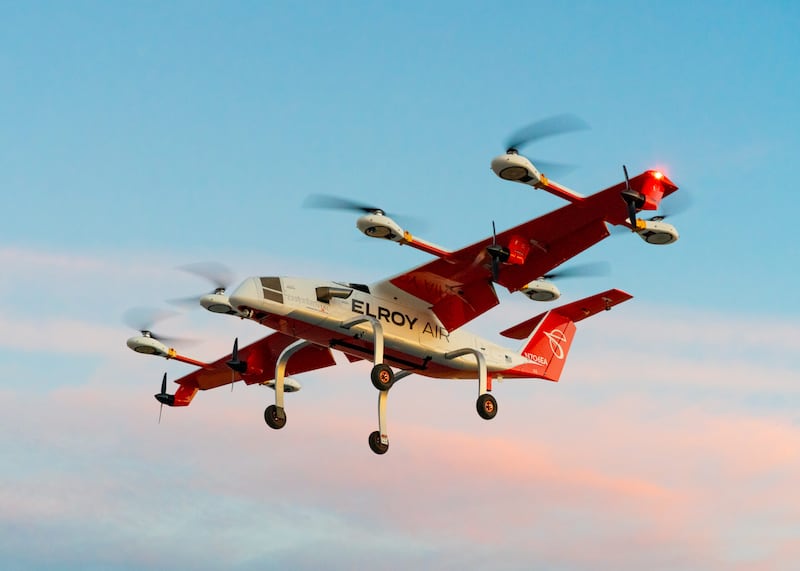Aaron Starks is beyond excited, and it’s 100 percent warranted.
“Imagine getting off your flight at Salt Lake City International Airport, stepping onto an air taxi, and arriving in Park City … or Heber … or Ogden … just 10 minutes later,” says Starks, CEO and president of 47G. “It’s very much the world you saw on Cartoon Network and growing up watching ‘The Jetsons,’ but we’re set to make it a reality.”
On May 30, Starks and Gov. Spencer Cox formally unveiled an effort to prepare the state for a new era of advanced technology — Project Alta (short for Air Logistics and Transportation Alliance).
Air travel is set to become more convenient — and important — in a myriad of new ways. There will be air taxis that obliterate commute times, packages delivered to front doors via drone, and time-sensitive organ donations, such as kidneys, arriving at hospitals faster than they ever have.
Throughout the state, various project partners have joined to form the Air Mobility Coalition (AMC). According to Starks, AMC will help catapult Utah into the future for the 2034 Winter Games, where Salt Lake City is the preferred host. If all goes according to plan, local low flying aircraft transporting cargo and people around the state will be on full display to the world by then.
From here to there
For the next 10 years, 47G and the Federal Aviation Administration (FAA) will work closely as part of AMC to regulate the use of automated air transport systems to ferry passengers and cargo briskly and safely throughout the state.
“Isn’t this industry cool? In 1969, we put someone on the moon. Now we’re talking about new space. We’re talking about air mobility. Unlike any other industry, this one brings out the best in people, both countries and companies. It pushes us to new limits, and we’re grateful to be a part of it.”AMC’s first order of business will be to establish a clear strategy for flights. There will be a lot of partnership and planning with the FAA to have flight paths approved for both cargo and tourism. That will mean a better understanding of weather patterns and infrastructural costs, which is where the state can help, Starks says.

“The timing is aggressive, but it would not shock me if we have several approved flights throughout Utah in time for the Olympics, along with several others for cargo delivery. Our urban air mobility will thrive, with groceries and packages delivered to homes throughout Salt Lake County and beyond.”
So far, there’s been nothing but support in trying to get this to happen. In addition to Gov. Cox acting as a “tremendous ambassador and supporter” of regulating this new technology, Starks says the Utah Department of Transportation (UDOT), the Governor’s Office of Economic Opportunity, and House and Senate leadership are helping pave the way for innovation.
It’s a unique chance to make Utah the first state to implement advanced air mobility (AAM), elevating the state’s status in this specific area, Starks says.
Drawing up the blueprints
Appointing Chris Metts as executive director of air mobility initiatives at 47G has been key to realizing AMC’s success. As the former deputy administrator of the FAA, Metts led air traffic control for the United States and helped write the white paper on AAM for NASA.
For his part, Metts believes Utah has everything it needs to be successful in this effort.
“This is not like the early days of aviation when it was trial and error. This is data collection, organized in a way that allows for success,” he says. “This is way cooler than ‘The Jetsons’ because this is real. This is the next generation of aviation. … This technology was cutting edge four years ago. It’s exceeded its expected capabilities. Companies are already engaging in these activities. This is an industry already in motion.”
While some drone deliveries are already happening within the state, their reach is set to extend far further, all across the Wasatch Front, flying south over the Oquirrh Mountains and into Cedar City or over the Great Salt Lake to Ogden or Layton.
Being the first state in the nation to establish AAM sets Utah up as an example for others to follow in future years, a blueprint of sorts.
“As a state, we have the opportunity to set the regulatory tone to allow for growth in this industry — across the country and around the world — in ways that show the leadership of Utah and how to be successful at this,” Metts says. “To be at the forefront, to set patterns, is very important.”
As plans continue to come together and regulation waits to pass, one thing is certain: Utah will look very different a decade from now.
“As somebody who was born and raised in this state, I’m excited for this opportunity to lead the nation in a way we haven’t historically: front and center of an emerging industry,” Starks says. “It’s going to impact Utahns in so many ways, from overall lifestyle to clean air to increased capital.”


